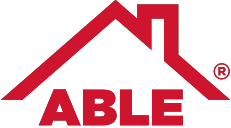No matter what type of siding material is on your home, you may notice that it has turned green in certain areas over time. Regardless of whether you have wood siding, aluminum, vinyl or UPVC, certain climatic conditions can cause mold, mildew, and algae to form on the surface of your siding, soffit, and trim. The truth of the matter is that many products that are maintenance-free require some attention from time to time.
How do algae and mold grow on siding?
Unless you have recently studied high school biology or have a degree in a related field, you most likely don’t know much about what mold, mildew, and algae are. Mold is a fungus, not unlike yeast, that often grows in damp places and aids in the decay of organic material. Mildew, a fungus similar to mold, is typically characterized as being white as opposed to the darker blue, green, black, and red shades associated with mold. Algae differ from molds and mildew in that they produce oxygen through photosynthesis. However, they don’t have root systems, like land plants, and are often single-celled organisms.
The reason you find these substances growing on your siding is because they thrive in damp conditions. There are typically found in shaded spots below the eaves and in certain areas of the home’s exterior – places where moisture tends to collect. The algae, mildew, and molds feed on sugars, dirt, dust, and other materials that collect on the siding. The sugars are especially appetizing to mold and mildew. So, “how is there sugar on the side of my house?” you may ask. The sugars come from trees that release tiny droplets of sugar and sap at various times throughout the year. If cleaning these substances off your home’s exterior is not included as a part of your spring and fall cleaning chores, they can proliferate and cause damage.
Sugars are not the only substances that these fungi and algae thrive on. At times, they are actually eating the sealants and stains that are used on wooden siding. Oil resins and alkyd are often used to make semi-transparent and clear coat products. Even if the products are made with chemicals intended to resist the growth of mold and mildew, exposure to the elements and bright sunlight have a degrading effect on the products, and they eventually break down.
What to do if you have green siding
If you are experiencing issues with mold, mildew, or algae growing on your siding, you may be tempted to go straight for the pressure washer, but you should consider other options before using high powered water. Using a pressure washer forces the water into crevices in the siding. This can erode some types of siding and do more harm than good. The intense stream of water may also get behind the siding, where it can damage wood, and create an even larger, less-sightly mold problem. The best way to remove these substances from your home is to follow these simple steps:
Step One
Shut all your windows and doors, cover delicate landscaping features with plastic, and cover outdoor electrical outlets with duct tape.
Step Two
Use your garden hose at a medium pressure spray to hose the siding down from top to bottom.
Step Three
Create a cleaning solution by mixing ½ pound of trisodium phosphate with two gallons of water. Another option you may choose, especially if the problem substances are very ingrained into the siding, is one-part chlorine bleach to four parts water. You may also use oxygen bleach as a safer alternative to chlorine bleach. For this solution, you will use 4oz. to 6oz. of bleach per gallon of water or follow the instructions on the packaging.
Step Four
Use a long-handled soft scrub brush to clean the siding with your cleaning solution. Brush side to side, from the top of the house down. It is best to work in sections of twenty feet in width at a time.
Step Five
Rinse the siding, again top to bottom, with your garden hose after scrubbing.
If you follow these simple steps to maintain your siding, it will stay clean and attractive for many years. If you encounter any damages or stains that you cannot clean off the siding using this method, reach out to Able Roof at (614) 444-2253 for assistance with all of your exterior home needs.








